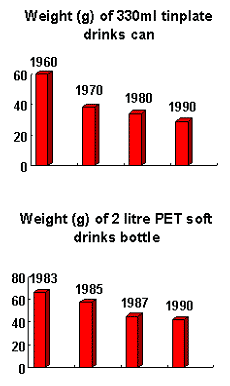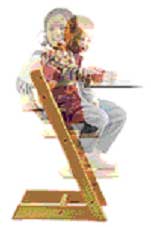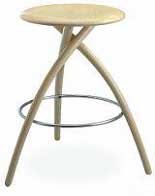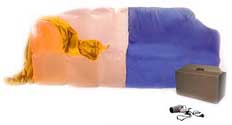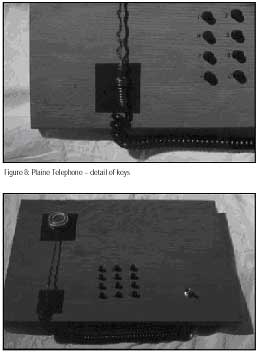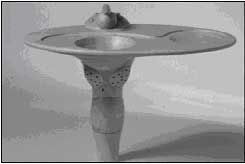|
Sustainable Design Awards Toolkit
Section 2.2 Reduce Design can help to directly reduce environmental impacts by making reductions throughout the whole products� life cycle: Reduce: material extraction Recycled or reclaimed materials could be used to eliminate environmental problems resulting from extraction. There are also alternatives to oil based plastics:
Bioplastics are plastics made from plants, usually polymers of starch or polylactic acid (PLA). They are being used for bags, cutlery and plates, pens, clothing, credit cards, food packaging, agricultural films, teabags, coffee filters, diapers and napkins. The main brands of the plastic itself are: Biopol, Bionolle, NatureWorks and Mater-Bi. These plastics are cyclic in their sourcing, with starch coming from plants, particularly in Europe where the "starch mountains" some years ago prompted the research that led to the development of starch plastics. It is also possible to make PLA from milk residues and even household waste.
In terms of material extraction and disposal alone it is thought to be better on the environment to use reusable cloth nappies instead of buying many disposable nappies. In terms of extraction: four and a half trees are destroyed to keep one baby in disposable nappies. In terms of disposal: disposable nappies have chemical granules inside them that can absorb many times their own volume in liquid - this material was not designed to be disposed of untreated into a landfill. A reusable nappy has none of these problems. Source: www.yummiesnappies.co.uk/WhyCotton.html Regardless of what type of nappy is used it is impossible to avoid some impact on the environment. Reusable cloth nappies require large quantities of electricity for washing and drying plus significant water use and chemical usage in the form of pre-wash soakers and detergents. www.thenappylady.co.uk/htm/environmental_costs_of_disposables.htm suggests that this does not outweigh the problems associated with disposable nappies, however: "It takes as much energy to make one disposable nappy as it does to wash a real nappy 200 times." Reduce: manufacture Making production as energy efficient as possible and reducing material wastage reduces the environmental impact and saves the company money. One way of making production more efficient is by using good design to reduce the number of components that assemble into a product. Each component is produced separately by a machine that requires energy to function. Reducing the number of components therefore reduces the number of machines operating. This reduces energy usage and also removes the environmental damage caused by the production of the machine and its associated tools and moulds. Ford at their Bridgend, Wales factory have installed $2.3m worth of solar panels. The panels are 'solar skylights' that not only contribute to the plant's power and lighting requirements, but also allow natural daylight to reach the workspace. Covering 25,000 square metres of the plant's roof, 26 solar units (incorporating 1540 photovoltaic cells) have been installed. This 97 kW system provides all the lighting requirements for the building beneath.
Reduce: Material Use There are several steps that manufacturers can take to reduce the amount of material used in a product or its package. One way is as subtle as "lightweighting" and therefore it often goes unnoticed to the general public. Lightweighting simply means using a different lighter resin mass or reducing the wall thickness to produce the same thing. A 2-litre plastic soft drink bottle used in the 1970s had a mass of 67g. Today a soft drink bottle weighs 47g. Plastic grocery bags have been reduced in thickness by over 1/3 between 1976 and 1990 without loss of strength.
���� Designers can substitute hazardous materials. This cardboard chair by ReturDesign and the Rondine armchair by Totem Italia both avoid the use of glues with their clever joint construction. Source: www.biothinking.com
Reduce: transportation
Reduce: water
Reduce: energy
|
Ecodesign Tools
|
|||||||||||
| � | |||||||||||
Toolkit Index
  |


